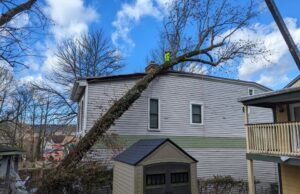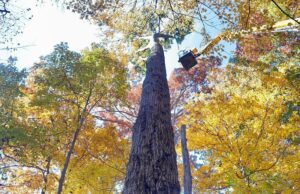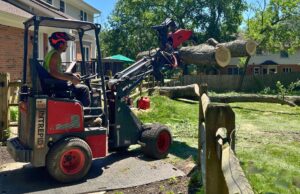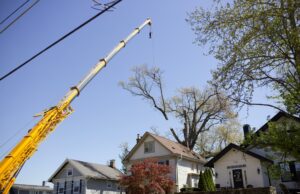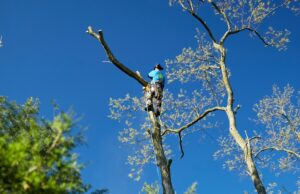Majestic oaks in neighborhoods like Hyde Park and Indian Hill have shaded Cincinnati homes for generations. Yet one pruning cut made at the wrong time can put them at risk of oak wilt, a deadly disease spread by tiny beetles carrying fungal spores. When pruning wounds are made in spring or summer, those beetles can infect even the healthiest tree, killing it within weeks.
The solution is simple: prune only during the safe season. From November through February, beetles are dormant, making it the best time to protect your oaks, preserve your property’s value, and keep Cincinnati’s tree canopy thriving for years to come.
Key Takeaways
- Oak wilt is a deadly fungal disease that invades your tree’s water-conducting system and spreads through beetle transmission and underground root connections.
- November through February is the only safe pruning window when disease-carrying beetles are completely dormant in Cincinnati.
- Pruning at the wrong time invites deadly infection as beetles actively carry oak wilt spores to fresh cuts from April through July.
- Cincinnati’s oak species respond differently to infection – red oaks die rapidly while white oaks may survive longer or recover.
- Working with Certified Arborists helps to protect your trees by following strict seasonal timing and using proper pruning techniques.
Why Does Oak Pruning Timing Matter in Cincinnati?
Pruning at the wrong time leaves oaks vulnerable to oak wilt, a lethal disease caused by the fungus Bretziella fagacearum. Once inside a tree, the fungus invades the water-conducting vessels and blocks the flow of water and nutrients. The tree responds by sealing off its own vessels, which only speeds up decline – essentially causing the oak to die of thirst from the inside out.
Fresh pruning wounds made during the growing season create an easy entry point for infection, and even a single cut at the wrong time can kill an otherwise healthy tree. That’s why pruning only during the dormant season is so important for keeping Cincinnati’s oaks strong.
How Does Oak Wilt Spread?
Oak wilt spreads in two ways. The first is through root grafts, where neighboring oaks have grown their roots together underground. Research shows that 90% of oak wilt infections spread through these root connections, moving from infected trees to healthy ones through the underground network.
The second method is through beetles. Sap-feeding nitidulid beetles are drawn to dead or dying oaks, where fungal spore mats develop beneath the bark. These mats release a sweet odor that attracts the insects and coat them with spores as they feed. When the beetles move on to a healthy oak with fresh pruning wounds, they carry the spores with them and introduce the infection directly into the tree.
When Can You Prune Oak Trees in Cincinnati?
Oak tree pruning should only be done between November and February, with some flexibility at either end depending on temperature patterns. This winter window is when oak trees are fully dormant and disease-carrying beetles are completely inactive.
The highest-risk period for oak wilt runs from April 15 through July 1, when sap-feeding beetles are actively feeding and pruning wounds are most likely to become infected. During this time, any fresh cut remains vulnerable for three to five days: long enough for the disease to take hold. That’s why experts strongly advise against pruning oaks in late spring and early summer.
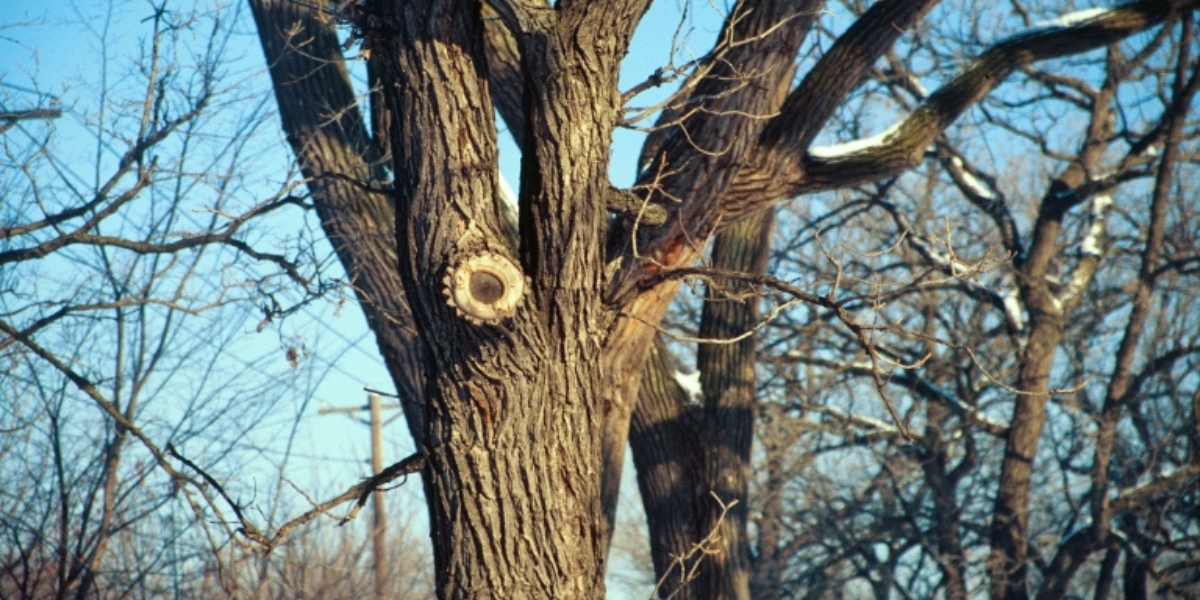
Photo courtesy of: Joseph OBrien, USDA Forest Service, Bugwood.org.
Can I Prune an Oak Tree with Storm Damage?
Sometimes severe storm damage forces oak work outside the safe window. If your oak suffers broken branches or other damage between April and October, contact a professional tree service immediately.
Certified Arborists can assess the situation and take proper emergency protocols, including applying latex paint or wound dressing to fresh cuts within minutes to create a barrier against beetles.
What Oak Trees Are Common in Cincinnati?
Cincinnati’s established neighborhoods feature several oak species, each with different susceptibility to oak wilt:
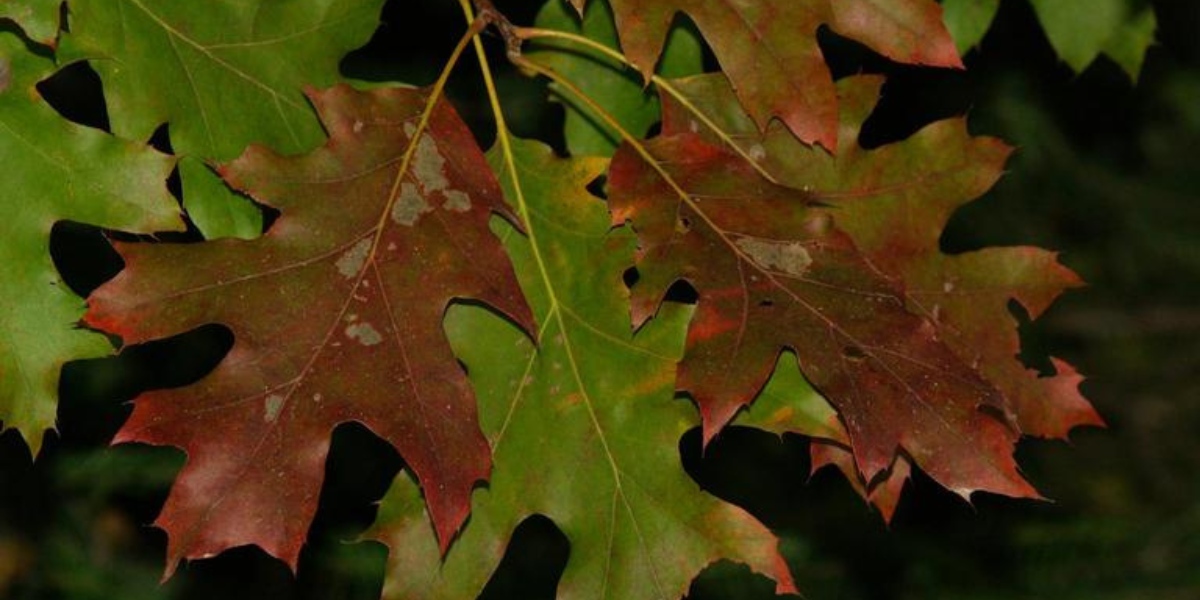
Photo courtesy of: Becca MacDonald, Sault College, Bugwood.org.
Red Oak Group (Highly Susceptible):
This group includes species with pointed, bristle-tipped leaves, such as northern red oak and pin oak. Northern red oak is one of the most common trees in Cincinnati neighborhoods, while pin oak is especially widespread in newer landscapes. Black oaks are also common across the region, often found on well-drained upland sites. Trees in this group are highly vulnerable to oak wilt and can die within weeks of infection.
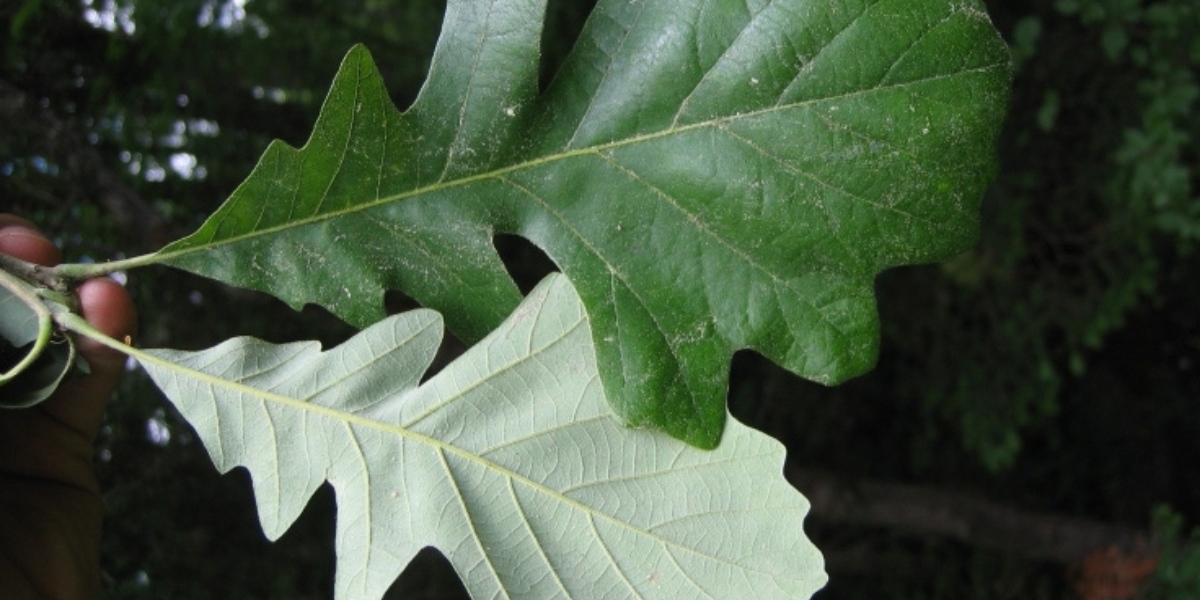
Photo courtesy of: Keith Kanoti, Maine Forest Service, Bugwood.org.
Bur Oak (Moderate Susceptibility):
Although botanically part of the white oak group, bur oaks are often considered separately because their response to oak wilt falls between red and white oaks. They are recognizable by their massive acorns with fringed caps and deeply lobed leaves. While less common than red or white oaks in Cincinnati, they appear in some landscapes and fall between red and white oaks in disease resistance.
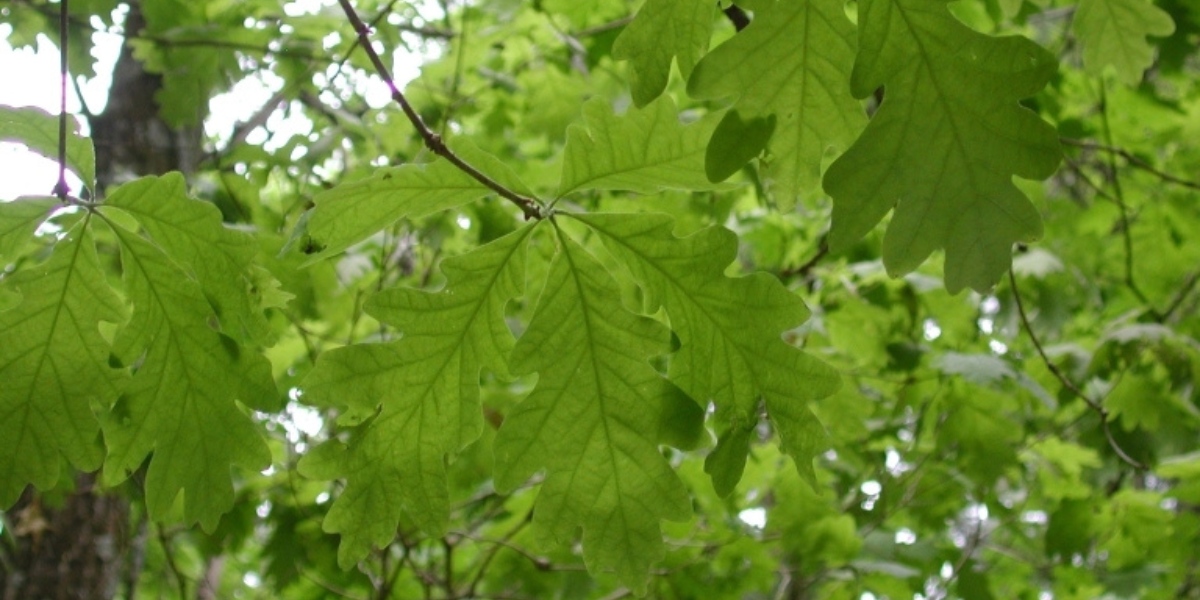
Photo courtesy of: Joseph OBrien, USDA Forest Service, Bugwood.org.
White Oak (More Resistant):
Species in this group, like white oak and swamp white oak, have rounded lobes without bristles. They are common in older neighborhoods such as Hyde Park and Clifton. These trees decline much more slowly if infected, and some can wall off the fungus and survive. However, they can still spread oak wilt to neighboring oaks through root connections.
If you’re unsure which oak species you have, a Certified Arborist can identify it during a property assessment. This identification helps determine the urgency of timing and the level of risk your tree faces.
Where Cincinnati’s Oaks Are Most at Risk
Oak wilt doesn’t threaten Cincinnati in the abstract – it endangers specific neighborhoods, each with its own mix of oak species, property values, and community priorities. From century-old specimens on estate grounds to mid-century plantings in suburban yards, the impact of pruning mistakes or disease outbreaks can look very different depending on where you live.
The following breakdown highlights key areas across Greater Cincinnati and the unique considerations homeowners, property managers, and communities face in protecting their oaks.
Hyde Park and Indian Hill
These affluent neighborhoods feature some of Cincinnati’s most valuable mature oak specimens. Large estate properties in Indian Hill often have multiple oaks that are 80-150 years old. Hyde Park’s tree-lined streets include many red and white oaks that define the neighborhood’s character. Property values in these areas make tree loss particularly costly.
Milford, Loveland, and Anderson
These residential areas have substantial oak populations on family properties. Homeowners here balance practical tree care costs with the desire to maintain safe, attractive yards. Many properties feature mature oaks planted 40-60 years ago that now require professional maintenance.
Clifton and Northside
Clifton’s historic Gaslight District features tree-lined streets with mature oaks integral to the neighborhood’s walkable character. Northside’s Parker Woods Nature Preserve contains oaks believed to be nearly 200 years old. These urban forest areas represent irreplaceable community assets.
Sharonville and Montgomery
Commercial properties and business districts in these areas have oak trees that require different considerations. Property managers need to balance liability concerns, tenant satisfaction, and professional appearance. Scheduling during winter minimizes business disruption.
Blue Ash and Avondale
Blue Ash might’ve been named for the native blue ash tree, but the area still has significant oak populations. Avondale is undergoing tree restoration initiatives, making the protection of existing mature oaks especially important for neighborhood revitalization efforts.
What Happens If You Prune Oaks at the Wrong Time?
Pruning oaks at the wrong time (during the growing season) leaves them vulnerable to infection at the very time disease risk is highest. A single cut made in spring or early summer can allow oak wilt to enter the tree and trigger a rapid decline.
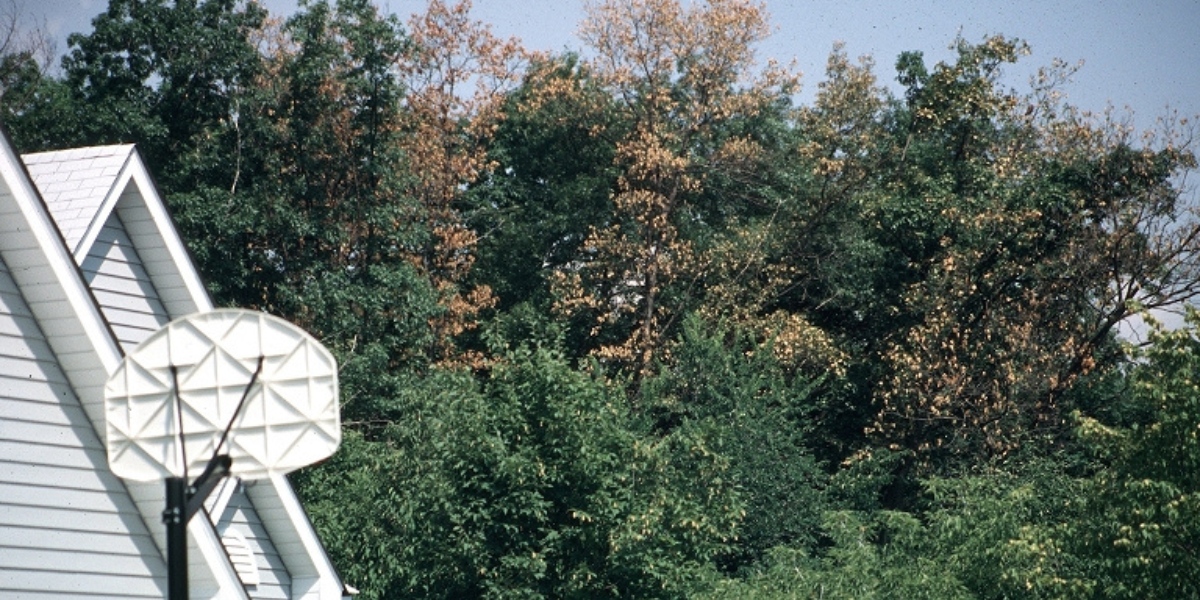
Oak wilt can spread quickly through neighborhoods, turning healthy canopies brown within weeks and threatening entire blocks of mature oaks – especially in areas with concentrated oaks like many Cincinnati neighborhoods. Photo courtesy of: Joseph OBrien, USDA Forest Service, Bugwood.org.
What Infection Looks Like in Your Tree
Once infected, trees in the red oak group (such as northern red, pin, and black oaks) show symptoms quickly:
- Leaves turn bronze or brown from the margins inward within two to four weeks
- Trees rapidly drop leaves, often while still partially green
- Branch dieback starts at the top and progresses downward
- The entire tree typically dies within a month of showing symptoms
Bur oaks tend to decline more slowly than red oaks but more quickly than white oaks. Symptoms may start on one section of the crown and spread through the tree over a season or two.
Trees in the white oak group decline at the slowest pace. They may show symptoms on one branch at a time over months or years. Some can wall off the infection and survive, but they remain carriers that can spread the disease to neighboring oaks.
How the Disease Spreads Beyond Your Tree
Oak wilt rarely stops with a single tree. Oaks of the same species often form natural root grafts underground, linking their root systems together. While these connections allow trees to share water and nutrients, they also create direct pathways for the fungus to spread. Once one tree is infected, oak wilt can quickly move through the roots to nearby healthy oaks turning a single case into a neighborhood problem.
The Real Costs of Wrong-Time Pruning
The consequences go far beyond the price of removal. Mature oaks add significant value to Cincinnati homes, enhancing curb appeal, neighborhood character, and overall property worth. Losing even one can reduce that value, while multiple losses can alter the look and feel of an entire street.
There are also liability risks. Under Ohio law, property owners may be held responsible if a diseased or poorly managed tree causes damage. If oak wilt develops after out-of-season pruning and spreads to a neighbor’s tree, you could face not only removal expenses but also legal and financial consequences.
“We see homeowners every year who didn’t understand the seasonal risk. By the time they notice symptoms in mid-summer, the tree is already dying. That’s why we refuse to prune oaks outside the safe winter window, even when customers ask. It’s not worth risking a tree that’s been growing for decades.” – Nick Lefke, Owner of Lefke Tree Experts
Cincinnati Oak Pruning Safety Calendar
| Month Range | Risk Level | Beetle Activity | Pruning Recommendation |
|---|---|---|---|
| November – February | Very Low | Inactive (dormant) | Safe for all oak pruning |
| March | Low to Moderate | Beginning to emerge | Avoid unless emergency |
| April – July | Very High | Peak activity | Never prune except emergencies with immediate wound paint |
| August – October | Moderate | Declining but present | Avoid unless emergency |
Safe oak pruning in Cincinnati is limited to winter months when beetles are dormant and cannot transmit oak wilt disease.
Frequently Asked Questions About Oak Pruning in Cincinnati
What’s the difference between structural pruning and crown cleaning for oaks?
Structural pruning focuses on improving your oak’s long-term form and stability by removing competing leaders, correcting growth patterns, and eliminating weak branch attachments. Crown cleaning removes dead, dying, diseased, or broken branches to improve tree health and reduce hazards.
Both services should only be performed during the November-February safe window for oaks. A Certified Arborist can assess which approach your tree needs based on its age, condition, and your property goals.
Does oak wilt disease affect other types of trees besides oaks?
Oak wilt is specific to oak trees and does not affect other tree species. The fungus Bretziella fagacearum only infects trees in the genus Quercus (oaks). This means your maples, ash trees, elms, and other non-oak species are completely safe from oak wilt, even if growing next to an infected oak.
However, recent research has detected the oak wilt fungus in chestnut trees, which are in the same family as oaks. If you have valuable oaks on your property, protecting them through proper pruning timing is essential, but you don’t need to worry about the disease spreading to your other tree species.
How long does it take for an oak tree to recover after proper winter pruning?
Recovery time depends on the extent of pruning and your tree’s overall health. Most healthy oaks show new growth within one growing season after winter pruning. Proper cuts made just outside the branch collar begin closing within weeks as the tree compartmentalizes the wound.
Heavy pruning, however, may take two to three years for the tree to fully adjust its energy distribution. A Certified Arborist will never remove more than 25% of a tree’s canopy in a single season to avoid stressing the tree.
What should I look for when hiring a tree service for oak pruning?
Verify the company employs ISA Certified Arborists, not just “tree trimmers.” Ask specifically about their oak pruning timing policy – any company willing to prune oaks between April and July should be avoided. Confirm they carry proper insurance, including general liability and workers compensation, and request references from recent oak pruning projects. A reputable company will provide a written estimate, explain their approach, and refuse to compromise on seasonal timing regardless of when you request service.
Protect Against Oak Wilt with Professional Oak Pruning in Cincinnati from Lefke Tree Experts
Don’t risk your valuable oak trees by pruning at the wrong time. With over 15 years serving Hyde Park, Indian Hill, Clifton, and neighborhoods throughout greater Cincinnati, our team of ISA Certified Arborists know how to protect your property investment and our urban forest.
Call us at 513-325-1783 or request your free estimate online to schedule pruning for your precious oaks this winter.

